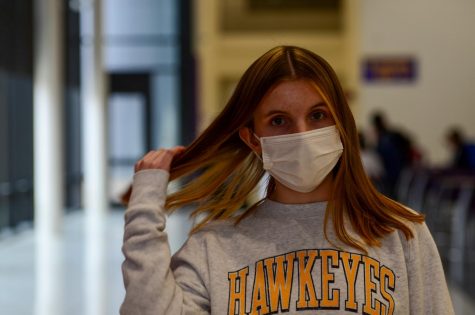Chronic Fatigue: More Than Just Being Tired
It’s common for high school students to be tired, but for two students, it’s much bigger than that.
Students socialize while Nitin Gupta ’21 leans on the table, exhausted.
November 12, 2018
Many high school students often struggle with being tired. Balancing school, extracurriculars, home life, work, and a social life makes sleep a low priority.
However, for Megan Woods ‘20 and her family, being tired is taken to a whole new level. Woods’ brother, Connor Woods ‘18, suffers from Kleine Levin Syndrome. Also known as KLS or Sleeping Beauty syndrome, this rare neurological disorder causes repeating episodes of extreme amounts of sleep and changing behaviors. “He sleeps 18 to 20 hours a day,” Woods said. “He usually only wakes up for food and to use the restroom, so we have to make sure the house is super quiet.”
In addition to keeping the house quiet, there are many other adjustments that the Woods family has had to make, such as keeping the house a temperature that is cool and comfortable enough to sleep in, and limiting the amount of people that come over. “I can’t always have friends over,” Woods said. “I’ll ask my mom and she’ll say ‘No, Connor’s not doing well.’ But my friends are very understanding of it, which is good. It’s almost like, built relationships with people because they’re there for me. So many people are bringing us over dinner and just making sure that we’re happy, and my mom goes out with her friends sometimes so she doesn’t always have to be watching and worrying about my brother.”
KLS occurs mostly in adolescents, but anyone can have it. According to the Kleine Levin Syndrome Foundation, “When awake the patient experiences confusion, disorientation, complete lack of energy, and lack of emotions. Most patients report that everything seems out of focus, and that they are hypersensitive to noise and light…KLS episodes may continue to reoccur for a decade or longer with devastating effects on the adolescent’s life and family.”
Woods says that having a sibling with KLS is a challenge, but in the end has brought her family closer together. “Before my brother got diagnosed, we were super close, and now I don’t see him as much,” Woods said. “Recently, I went a week without seeing him, and we were in the same house together. He was sleeping so much that I just never saw him, so that’s hard because it’s kind of like losing a friend. Our family gets stressed so much quicker, but we’ve become more supportive of each other…Instead of fighting against it, if we work together, it will be better for everyone. Even though it’s not a solution, it’ll help us work towards the solution.”
Diagnosing KLS can be tricky, because there are no known causes of it, and doctors must rule out any other factors that could be causing the extreme drowsiness before saying that it’s KLS. “He’s had it since his freshman year, so about four years now,” Woods said. “His diagnosis didn’t come until a year or a year and a half after he’d been sleeping a lot.”
In Woods’ case specifically, the doctors think that his multiple concussions in a relatively short amount of time may have triggered the disorder, but nobody is certain.
Another disease, called myalgic encephalomyelitis, has been affecting Ethan Hartle ‘19. This disease is also known as ME and chronic fatigue syndrome. “The condition is an autoimmune like disease and is not contagious,” Hartle said. “It disrupts functionality in the mitochondria, and interferes with white blood cells. The fatigue is so extreme that it weighs me down so it is difficult to move.”
Symptoms of ME include extreme exhaustion, loss of memory and/or concentration, unexplained muscle or joint pain, headaches, unrefreshing sleep, and stomachaches. According to the Centers for Disease Control and Prevention, “Most people with ME/CFS have trouble thinking quickly, remembering things, and paying attention to details. Many patients often say they have ‘brain fog’ to describe this problem because they feel ‘stuck in a fog’ and not able to think clearly.”
Before being diagnosed, Hartle was involved in many activities such as cross country, track, marching band, and show band. “Now I can hardly walk a quarter-mile without resting on good days, or even a few meters on bad days,” Hartle said. “Because of this, I have been unable to attend school, though I’m still on track to graduate with the help of a couple of teachers.”
Those staff members include special education teacher Patrick Mattingly, social studies teacher Benjamin Knight, English teacher Mark Schillerstrom, and assistant principal Jerry Stratton. “I’ve been working with Ethan just to kind of get him back into the groove of academics,” Mattingly said. “He had been out for a long time, and they needed somebody to come and make sure that somebody could proctor academics in English and in government. I was his coach in cross country and track, and they asked me if I would be willing to do that and I was more than happy. I’ve been doing that for the last few weeks. I come to his house, and it’s been a good learning experience.”
Mattingly visits Hartle at home to work with him, and he says that Hartle has been doing well. “The days that I’m visiting him he’s had very good days,” Mattingly said. “But I know that he has bad days, and he crashes, and so he’s not able to sit and read or type on the computer very long. That’s hard for him, but he’s really done well. There hasn’t been much of a difference, other than it’s at home versus school… Everyday is a fight for him…This is a very real thing, and it’s a struggle. He’s done a wonderful job and had an amazing attitude. I think that’s really the key, to fight every day. I just feel fortunate enough to help him.”
Hartle was diagnosed at the beginning of this year, and has since had to make many sacrifices. “On my bad days I need to use a wheelchair to get around the house,” Hartle said. “It also affects my concentration and it’s hard for me to keep up with schoolwork… I went from being an extremely active and dedicated student, to not being able to attend school a single full day this year…Although, I am blessed to know that a lot of people are praying and thinking of me, and I really appreciate it.”
One of those people in particular is Matthew Kliegl ’20. Kliegl runs cross country and participates in band and show band with Hartle. “He’s always been kind of a role model to me,” Kliegl said. Kliegl has not been able to see Hartle as much due to his condition. “It’s definitely been different because I haven’t seen him as much, and that guidance he once provided isn’t there anymore,” Kliegl said. “He was always there if you had a bad race or something to pick you up and encourage you to do better.”
Kliegl says that Hartle has always been a leader and shaped him into who he is today. “I think that the leadership that he provided has definitely turned me into a better leader for our team,” Kliegl said. “I think that he’s shown what a good teammate looks like and provided an example of what to strive for.”
Having a friend with this condition has been a challenge for Kliegl. “Knowing that he’s going through so much troubles just kind of sucks,” Kliegl said. “It’s hard for him to do daily functions. Knowing that he was once running seven to eight miles a day with us, and now he can’t even walk and it’s hard for him to even eat sometimes, it just sucks to know that.”
ME is a fairly common condition, affecting between 800,000 and 2.5 million people worldwide. There is a large gap in the number of people because it is a difficult condition to identify. “There is no test to determine that you have ME, it has to be diagnosed through eliminating everything else,” Hartle said. “There is no cure to fight ME directly, though I have a symptom management plan. This includes a lot of rest, limited physical and mental activity, and changes in my diet.”
Fortunately, because he was diagnosed at a younger age than other people, Hartle’s doctor said that his first two years will probably be the worst of it. After that, his symptoms may lessen. However, ME affects everybody differently and many people suffer very severe symptoms for most of their lives.

















Nadine • Nov 15, 2018 at 9:29 am
Thank you for your research and writing this article to bring awareness to these life altering conditions that teenagers and their families are struggling with. Well done!